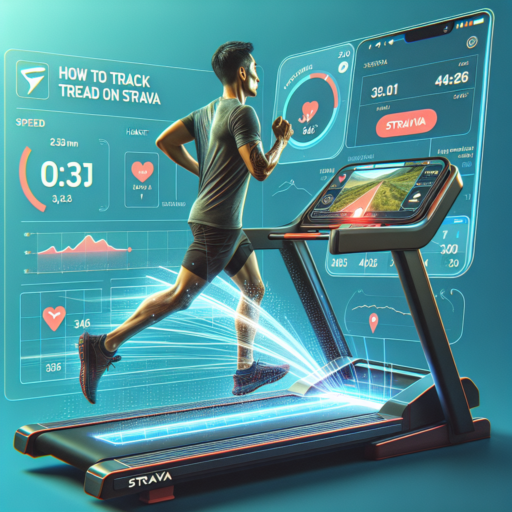No se han encontrado productos.
Introduction to Tracking Treadmill Runs on Strava
Strava, a leading platform for tracking exercise routines, has always been at the forefront of innovation, allowing athletes and enthusiasts alike to monitor their outdoor runs with precision. However, the challenge of accurately tracking indoor activities, particularly treadmill runs, presents unique obstacles. Strava’s comprehensive approach to integrating treadmill data ensures users can enjoy the full spectrum of its features, even when training indoors.
With the rise in popularity of home workouts and gym sessions, especially amid global health concerns, there’s a pressing need for a seamless method to record and analyse treadmill workouts. Tracking treadmill runs on Strava not only offers the community aspect of sharing and competing with friends but also provides in-depth data analytics. This includes pace, distance, heart rate, and more, enabling users to monitor their progress comprehensively.
Setting Up Your Strava for Treadmill Runs
Initiating Strava for treadmill tracking requires a few simple steps, starting with ensuring your device is compatible and connected. Whether using a smartphone, smartwatch, or a fitness tracker that supports synchronization with Strava, the process involves selecting the ‘treadmill’ or ‘indoor running’ option from your device before starting your session. This guarantees that the data collected is tailored for an indoor workout scenario, focusing on the relevant metrics without requiring GPS data.
Understanding the importance of accuracy in tracking, Strava has fostered partnerships with leading fitness equipment brands to streamline data sharing. This allows for more precise recording of each run, reflecting true effort and progress. By embracing technology such as foot pods and wearable devices, users can enhance the quality of the data captured, leading to a richer, more detailed activity log on their Strava profile.
Step-by-Step Guide to Manually Log Treadmill Runs on Strava
Manually logging treadmill runs on Strava doesn’t need to be a complicated process. With this simple step-by-step guide, you’ll be able to record your indoor workouts and share them with your Strava community in no time. Ensuring your efforts on the treadmill are tracked and stored can help you monitor your progress, keep motivated, and even compete with friends.
Step 1: Open Your Strava App
Start by opening your Strava app on your mobile device. Make sure you’re logged into your account. If you don’t have the app yet, download it from the App Store or Google Play Store and set up an account to get started.
Step 2: Access the Manual Entry Screen
Once you’re in the app, locate the «+» icon on the bottom of the screen, often situated in the center. Tap on it, then choose «Manual Entry» from the pop-up options. This will take you to a screen where you can manually input your workout details.
Step 3: Fill in Your Treadmill Run Details
On the manual entry screen, you’ll find several fields to fill in. Select «Run» for your activity type. Proceed to input the duration (hh:mm:ss) and distance (km/miles) of your treadmill run. Strava allows you to add additional details such as your perceived exertion, how you felt during the run, and any notes on the treadmill settings or intervals. Adding these details can provide a more comprehensive overview of your workout. When you’re done, click «Save» to log your run.
Best Practices for Accurate Treadmill Data on Strava
Ensuring your treadmill activities are accurately reflected on Strava not only helps in tracking your performance over time but also allows for a better comparison and sharing of your fitness journey with the Strava community. To achieve this, specific best practices can be followed, enhancing the quality and reliability of the data recorded.
Calibrate Your Treadmill Regularly
One critical step in ensuring the accuracy of treadmill data on Strava is the regular calibration of your treadmill. Calibration helps in aligning the treadmill’s speed and distance measurements with real-world values, which is essential for consistent data recording. Before starting your workout, ensure that your treadmill’s calibration settings are up to date, considering any wear and tear that might affect its accuracy.
Use External Sensors
Incorporating external sensors, such as foot pods or heart rate monitors, can significantly improve the quality of the data collected. These devices can provide more precise measurements of your pace, distance, and effort, which are crucial for a comprehensive analysis of your performance. Connecting these sensors to Strava ensures that the app receives the most accurate information directly from your treadmill workout.
Manually Check and Edit Data When Necessary
Despite the best efforts to calibrate equipment and use external sensors, sometimes the data captured might not perfectly reflect your activity. In such cases, Strava allows for the manual editing of activity details. This means you can adjust the distance or time recorded if you notice discrepancies. Performing a regular audit of your Strava activities can help in maintaining the integrity of your fitness records, ensuring that your progress and performance are accurately tracked over time.
By following these best practices, Strava users can enhance the accuracy of their treadmill data, making every step count towards their fitness goals.
Using External Devices to Automatically Sync Treadmill Activities to Strava
Integrating your treadmill activities with Strava doesn’t have to be a manual chore. Thanks to a variety of external devices, this process can now be seamless, allowing you to track and analyze your indoor running sessions just as you would your outdoor efforts. In the universe of fitness, connecting your treadmill exercises automatically to Strava amplifies the motivational aspect by letting you share and compare your progress with a global community.
Compatible Devices for Seamless Integration
The key to automating your treadmill activities to Strava lies in the compatibility of your devices. Several smart treadmills and fitness trackers are designed specifically for this purpose. Devices from brands like Garmin, Polar, and Wahoo have built-in features that sync your workouts directly to Strava without any extra steps required from you. This enables a real-time update of your indoor activities, mirroring the effort you put in as accurately as possible.
Setting Up Your Device for Synchronization
Setting up your external device for a flawless Strava sync begins with ensuring your gadget is compatible. Once confirmed, the process typically involves linking your Strava account with the device’s native app. This procedure is straightforward for most users: simply navigate to the settings or connections section of the app, find Strava, and authorize the connection. Instantly, your treadmill runs will start reflecting on your Strava account, accurately displaying your pace, distance, and duration alongside those exhilarating outdoor challenges.
From diligent enthusiasts to casual joggers, the ability to automatically sync treadmill activities to Strava using external devices revolutionizes the way we view indoor running. It not only bridges the gap between indoor and outdoor workouts but also enriches the quality of our fitness data, making every step count in our journey towards better health and performance.
Optimizing Your Treadmill Workouts on Strava with Personal Bests and Achievements
Strava has revolutionized the way we track and optimize our treadmill workouts, making it easier than ever to chase personal bests and collect coveted achievements. By focusing on these competitive yet personal targets, runners can push their limits and see tangible progress in their fitness journeys. Understanding how to leverage Strava’s features effectively can transform an ordinary treadmill routine into a dynamic and rewarding training session.
First and foremost, setting up your Strava account to accurately track indoor activities is crucial. Strava’s ability to seamlessly integrate with various smart treadmills and devices ensures that every step you take contributes towards your personal bests and achievements. Highlighting the importance of consistency, it’s essential to regularly update your performance metrics on Strava to keep your goals in sight and achievable. Unlocking achievements and setting new personal records not only boosts motivation but also provides a structured framework for gradual improvement.
To further enhance your treadmill workouts, Strava offers a range of features and tools designed for detailed performance analysis. Exploring segments, even virtual ones tailored for treadmill runners, can add an exciting competitive edge to your runs. By comparing your efforts against your past performances or those of friends, you’re able to set realistic and challenging goals. This direct comparison encourages a healthy competitive spirit and fosters an environment of continuous improvement and personal growth within the Strava community.
Strava’s social aspect also plays a pivotal role in optimizing your treadmill workouts. Joining challenges and participating in community events are excellent ways to stay motivated and connected with like-minded individuals. The encouragement and support from fellow runners can be the extra push needed to surpass your previous achievements and strive for higher milestones. Integrating these social features with your personal workout goals on Strava creates a comprehensive fitness regime that is both rewarding and fun.
How to Adjust Your Treadmill Data for Elevation and Incline on Strava
Adjusting your treadmill data for elevation and incline on Strava can significantly enhance the accuracy of your workout records, which is crucial for athletes seeking to track their progress and performance accurately. Strava, as a popular fitness tracking platform, offers several ways to manually input or correct your treadmill activities to reflect true effort levels, especially when elevation or incline is involved.
Firstly, when uploading your treadmill run to Strava, you should accurately include the incline percentage your workout was performed at. This is often overlooked but is a critical step in ensuring that your virtual elevation gain mirrors your physical effort. To adjust this, go to the manual entry section for your treadmill activity and find the option to edit elevation. Here, entering the average incline of your run will allow Strava’s algorithm to calculate a more precise elevation gain for your workout.
Additionally, for users wanting to fine-tune their data further, Strava allows for the manual entry of elevation gain post-upload. This can be particularly useful if you’ve forgotten to adjust the incline or if the default elevation data doesn’t accurately represent your effort due to treadmill inaccuracies. Navigate to the specifics of your run within the Strava app or website, select «Edit,» and then manually adjust the elevation gain based on the incline percentages you’ve tackled during your workout.
Comparing Indoor and Outdoor Runs on Strava
Strava, as a leading fitness platform, offers runners comprehensive insights and tools to track their progress, whether they’re hitting the pavement or clocking miles on a treadmill. Understanding the fundamental differences between indoor and outdoor runs on Strava not only helps athletes in setting realistic goals but also in tailoring their training routines more effectively. The platform’s ability to dissect and display diverse data points makes this comparison all the more interesting for fitness enthusiasts.
Accuracy of GPS and Treadmill Data: One of the key aspects to consider when comparing indoor and outdoor runs on Strava is the source of data. Outdoor runs rely heavily on GPS to track distance and pace, which can offer a high level of accuracy in open areas. On the flip side, indoor runs often depend on the treadmill’s data output, which Strava then interprets. The calibration of your treadmill can greatly influence the accuracy of the data reported, making it essential for users to understand the potential discrepancies between their treadmill and Strava’s recordings.
Another significant factor is the type of experience each environment offers. Outdoor running is affected by varying weather conditions, terrain, and elevation changes, all of which are captured and analyzed by Strava. In contrast, indoor running provides a controlled environment, albeit without the natural elements and challenges. This difference can impact a runner’s performance, pace, and endurance, thereby affecting the comparison of workout data on Strava.
Engagement and Motivational Factors: Strava’s social features also play a crucial role in comparing indoor and outdoor runs. Outdoor runs often come with the added motivational boost of scenic views and the possibility of participating in community challenges. Although indoor runs might miss out on these aspects, Strava’s community features and personal achievement milestones can still provide a significant motivational uplift for treadmill enthusiasts.
Frequently Asked Questions About Treadmill Tracking on Strava
Strava has become a go-to platform for tracking various physical activities, including indoor workouts like treadmill runs. However, users often have questions about the specifics of tracking these sessions on Strava. Here, we address some of the most commonly asked questions.
How to Ensure Accurate Treadmill Data on Strava?
Ensuring your treadmill activities are accurately represented on Strava begins with the setup. Users should manually enter their treadmill runs, paying close attention to the distance and pace displayed by their treadmill. Additionally, linking a foot pod or smartwatch that accurately measures indoor distance can enhance the precision of reported data.
Can Strava Automatically Track Treadmill Runs?
While Strava excels at GPS tracking for outdoor activities, it requires a bit of manual input for treadmill runs. After completing your activity, you can manually add your run to Strava. For a more streamlined experience, syncing a compatible device that records your treadmill session can automate the process, pulling data such as duration, heart rate, and pace directly into your Strava activity.
Is Calibration Necessary for Accurate Tracking?
Calibration plays a crucial role in the accuracy of treadmill tracking on Strava. Devices such as foot pods or smartwatches may need calibration to align their data with the actual distance covered on the treadmill. Most devices offer a simple calibration process, ensuring that your treadmill workouts are precisely recorded on Strava, reflecting your true effort and progress.
Community Tips for Getting the Most Out of Treadmill Workouts on Strava
Maximize Your Treadmill Workouts with Strava Insights
Embracing the power of Strava can transform your treadmill sessions from mundane to motivational. Strava’s avid user base has a wealth of knowledge on making indoor runs more effective and engaging. One of the top tips from the community is to utilize Strava’s segment feature. Even though you’re on a treadmill, you can manually create segments that mimic outdoor routes. This feature enables you to compete against yourself or others, pushing your limits and tracking your progress over time. It’s all about setting personal benchmarks and striving to surpass them, making each treadmill workout a step towards your fitness goals.
Engage with the Strava Community for Support and Motivation
The Strava community is known for its supportive and motivating environment. Engaging with fellow runners on the platform can significantly enhance your treadmill workouts. Community members often share customized indoor running challenges, which can add a fun and competitive element to your routine. Joining these challenges or even starting your own encourages accountability and keeps motivation high. Additionally, swapping stories and advice on workout strategies or the best playlists for running can make your treadmill sessions more enjoyable and productive.
Track and Analyze Your Indoor Performance Consistently
One of the most valuable aspects of using Strava for treadmill workouts is the ability to track every aspect of your run. Strava provides detailed analytics on your performance, including pace, distance, heart rate, and more. This data is crucial for identifying trends in your workouts, understanding your strengths and weaknesses, and setting informed goals. The community recommends regular review of your Strava metrics to monitor improvements and adjust your training plan accordingly. By focusing on personalized data and community feedback, you can make each treadmill workout on Strava a meaningful step towards your fitness achievements.




